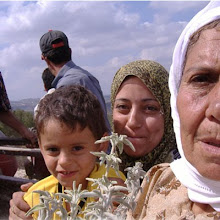View from Jayyous Town Hall looking west towards Israel. The horizontal brown scar across the picture is the Separation Fence. The Green Line—the internationally acknowledged Israel/West Bank border—follows the horizontal edge of the green area in the middle distance. The lands belonging to Jayyous farmers on the Israeli side of the Fence are between the two. Some lands were confiscated. Some are still owned by Jayyous farmers who can farm them if they can get the necessary permits from the Israelis. Many can not.
The photo shows that the Wall/Fence in the Jayyous area was not built on the Green Line, the internationally recognised future border between Israel and the putative state of Palestine, but several km to the east, thus confiscating some land from Jayyous farmers but leaving some land in their possession in what is called a "Seam Zone"—see photo. To access their land, these farmers need a permit to cross through the agricultural gates provided for this purpose, and these permits are difficult to obtain and frequently withdrawn.
This morning the last farmers to arrive at the gate just before it was supposed to close at 0745 was a group of four young men and an older one in a yellow Mercedes lorry. It and they come most days to harvest crops—today Za'atar and wheat—which they then sell in the market in Nablus some 20km away, and no one expected a problem. However one of the young men was told he had been blacklisted by the Shebat, the Israeli version of MI5, and could not cross despite his permit being in order. This seemed unlikely because, apart from his having a valid permit, his father has a permit to work in Israel for which you have to be squeaky clean in security terms. So the men protested and the soldier went off to phone for confirmation. At 0830 the young man was told he could cross, and off they all went having lost 45 minutes work time. The 45 minutes we waited was pleasant enough in one way. It was sunny, the four soldiers chatted together as did the Palestinians, and I chatted to one of the young men who spoke some English. He told me among other things that three of them were recent university graduates in history, accounting and finance, but none could find a job to use their skills and training. He himself wanted to get married but couldn't until he found a job.
But this is just the 10% of ice on the iceberg of the Occupation. I want to draw your attention to the 90% which people often don't see or think about.
· First: these men were trying to access their land. Why should they have to go through all this to simply work their land? There are, of course, farmers who have actually had their land taken by Israel, but that's another story covered in my previous Report #15.
· Second: Israel is fully entitled to build a Wall/Fence along its border for security reasons if it wishes to. But the Wall/Fence here (and along most of its route) was not built on the Green Line but on Palestinian land. Israel claims the Wall/Fence is for security reasons and no doubt this is partly true. But it is also clear that the route of the Wall/Fence is designed to include within Israel all the settlements along the edge of, and sometimes far within, the West Bank, thus pre-empting any peace agreement with the Palestinians on borders. This is true in the Jayyous area: the Wall/Fence pursues a zig zag route precisely to include several settlements within Israel. It was for this reason that the International Court of Justice in an advisory ruling in July 2004 stated that the Wall is illegal, that it should be demolished where it isn't on the Green Line, and that Israel should pay compensation to those adversely affected by it (see www.icj-cij.org/docket/files/131/1677.pdf). Israel has ignored this ruling and has continued to build the Wall/Fence in precisely the way that was condemned.
· Third: the ICJ in its ruling also described in paras 154-159 the obligations of other States in respect of this illegal Wall. These are:
o not to recognise the illegal situation caused by the Wall;
o not to render aid and assistance in maintaining the situation;
o to see that any impediment to the exercise by the Palestinian people to self-determination is brought to an end; and
o ensure that Israel complies with International Law.
· Fourth: it is clear to me that no State or part of the international community, for example, the EU, has made any attempt to fulfil its legal obligations as given above. The USA continues to support Israel with lots of government aid and private tax-aided donations, the EU to offer favourable trading conditions, and as is obvious here, many countries ameliorate the conditions caused by the Wall/Fence rather than trying to get Israel to move it to the Green Line. Hence the UK, the EU and the USA are all complicit in the situation my farmer friend found himself in this morning. "Not in my name!".
Mike Barnes, 30 May 2010


